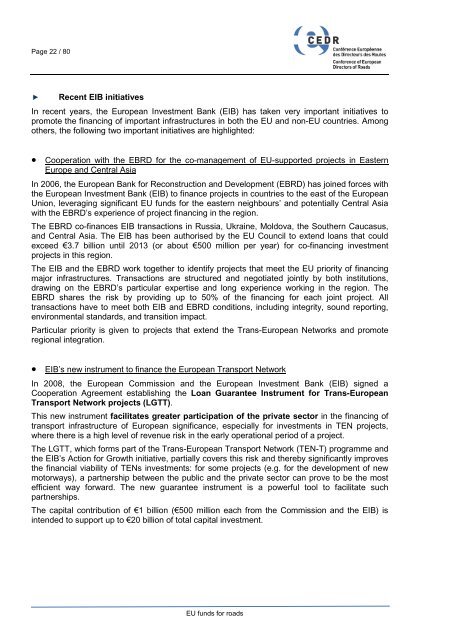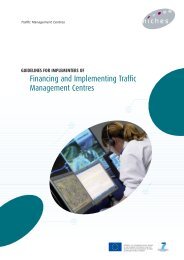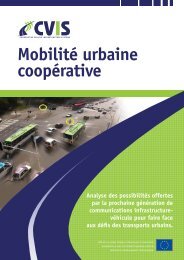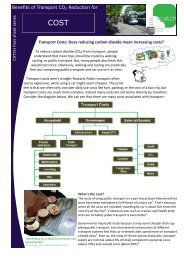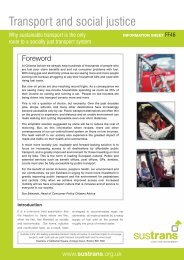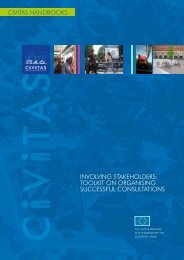EU funds for roads - CEDR
EU funds for roads - CEDR
EU funds for roads - CEDR
Create successful ePaper yourself
Turn your PDF publications into a flip-book with our unique Google optimized e-Paper software.
Page 22 / 80<br />
Recent EIB initiatives<br />
In recent years, the European Investment Bank (EIB) has taken very important initiatives to<br />
promote the financing of important infrastructures in both the <strong>EU</strong> and non-<strong>EU</strong> countries. Among<br />
others, the following two important initiatives are highlighted:<br />
• Cooperation with the EBRD <strong>for</strong> the co-management of <strong>EU</strong>-supported projects in Eastern<br />
Europe and Central Asia<br />
In 2006, the European Bank <strong>for</strong> Reconstruction and Development (EBRD) has joined <strong>for</strong>ces with<br />
the European Investment Bank (EIB) to finance projects in countries to the east of the European<br />
Union, leveraging significant <strong>EU</strong> <strong>funds</strong> <strong>for</strong> the eastern neighbours’ and potentially Central Asia<br />
with the EBRD’s experience of project financing in the region.<br />
The EBRD co-finances EIB transactions in Russia, Ukraine, Moldova, the Southern Caucasus,<br />
and Central Asia. The EIB has been authorised by the <strong>EU</strong> Council to extend loans that could<br />
exceed €3.7 billion until 2013 (or about €500 million per year) <strong>for</strong> co-financing investment<br />
projects in this region.<br />
The EIB and the EBRD work together to identify projects that meet the <strong>EU</strong> priority of financing<br />
major infrastructures. Transactions are structured and negotiated jointly by both institutions,<br />
drawing on the EBRD’s particular expertise and long experience working in the region. The<br />
EBRD shares the risk by providing up to 50% of the financing <strong>for</strong> each joint project. All<br />
transactions have to meet both EIB and EBRD conditions, including integrity, sound reporting,<br />
environmental standards, and transition impact.<br />
Particular priority is given to projects that extend the Trans-European Networks and promote<br />
regional integration.<br />
• EIB’s new instrument to finance the European Transport Network<br />
In 2008, the European Commission and the European Investment Bank (EIB) signed a<br />
Cooperation Agreement establishing the Loan Guarantee Instrument <strong>for</strong> Trans-European<br />
Transport Network projects (LGTT).<br />
This new instrument facilitates greater participation of the private sector in the financing of<br />
transport infrastructure of European significance, especially <strong>for</strong> investments in TEN projects,<br />
where there is a high level of revenue risk in the early operational period of a project.<br />
The LGTT, which <strong>for</strong>ms part of the Trans-European Transport Network (TEN-T) programme and<br />
the EIB’s Action <strong>for</strong> Growth initiative, partially covers this risk and thereby significantly improves<br />
the financial viability of TENs investments: <strong>for</strong> some projects (e.g. <strong>for</strong> the development of new<br />
motorways), a partnership between the public and the private sector can prove to be the most<br />
efficient way <strong>for</strong>ward. The new guarantee instrument is a powerful tool to facilitate such<br />
partnerships.<br />
The capital contribution of €1 billion (€500 million each from the Commission and the EIB) is<br />
intended to support up to €20 billion of total capital investment.<br />
<strong>EU</strong> <strong>funds</strong> <strong>for</strong> <strong>roads</strong>


